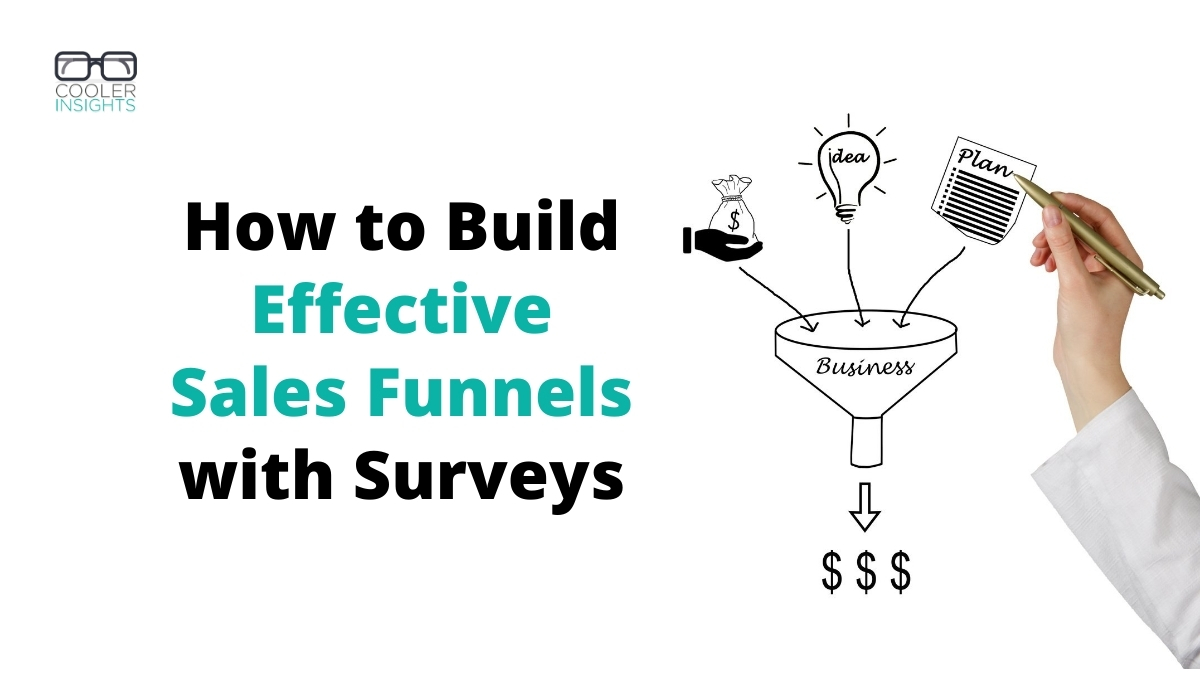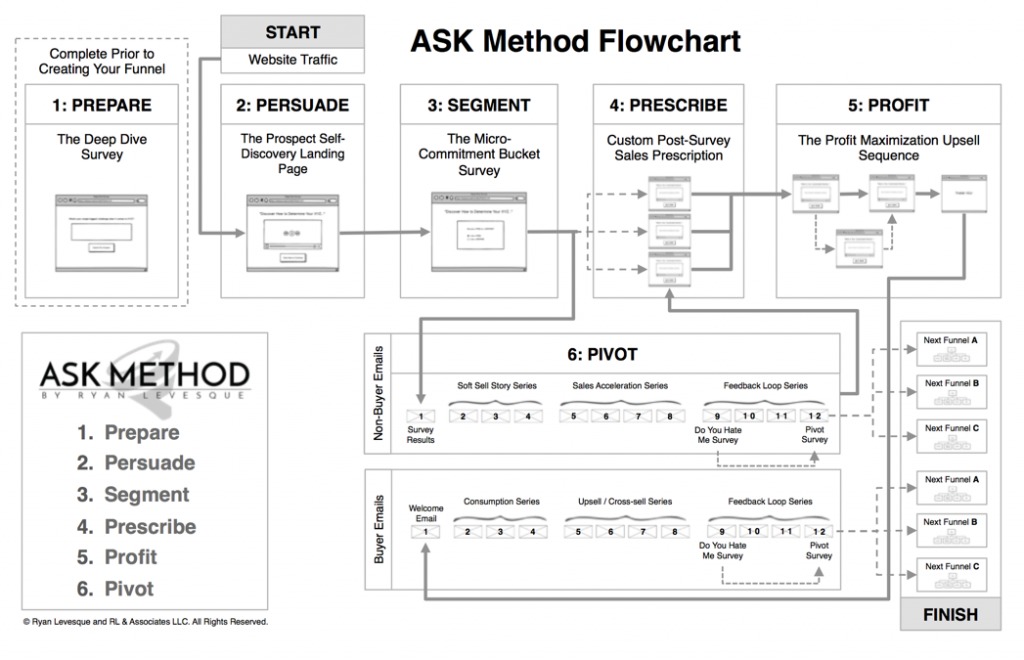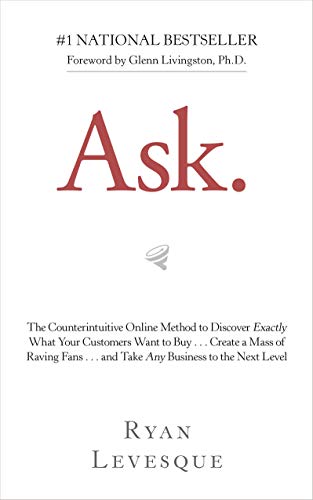
Sales and marketing funnels are all the rage these days. Building an effective one, however, requires you to ask the right questions.
Comprising a sequence of content types and channels — ads, posts, landing pages, emails, and auto-responders — sales funnels can help you to optimize your digital marketing results.
But how do you build a funnel that precisely meets both your customer’s and your business’s needs?
Enter the ASK Method by digital entrepreneur Ryan Levesque. Comprising a series of surveys spread across different online channels, his Survey Funnel Strategy is touted to help countless businesses to achieve millions of dollars in sales.
Curious to know how it works, I picked up a copy of the book (you can get it for free here), and learned how it can help businesses to…
- Understand what your potential customer wants to buy
- Build trust, commitment and willingness to buy from your prospect
- Switch your offer to better match what prospects want
In this article, you will get a brief overview of how the ASK method works, and how you can implement them in your business.
The Pillars of the Survey Funnel Strategy
The ASK Formula comprises six steps (Prepare, Persuade, Segment, Prescribe, Profit, Pivot), and four primary surveys:
- The “Deep Dive” Survey
- The “Micro-Commitment Bucket” Survey
- The “Do You Hate Me” Survey
- The “Pivot” Survey
This process follows a flowchart that looks like this:

Courtesy of Ask Book
Let’s go into each of the steps involved.
#1 Prepare — The Deep Dive Survey
This first step involves coming up with a comprehensive survey to find out what your customers really want, who they are, and how you can market to them by sorting them into “buckets” (segments).
You can use a survey tool like SurveyGizmo, SurveyMonkey, or Google Forms for this exercise.
Here are the steps involved:
- Write an email to your list (or you can run it as an ad to a cold audience, and situate your survey on a landing page).
- In your email or ad, ask them this open-ended question: “What’s your single biggest challenge in _______ right now?” Fill in the blanks according to the business area that you’re focused on (eg it could be “Social Media Marketing” for me.) and encourage them to give you as much detail as they need.
- For the subsequent questions in the survey, include “sorting questions” (preferably MCQ) such as their occupation type (full-time or part-time), size of business (sales per year), niche/market, contact particulars (name, email, phone number, website).
- Analyse your responses on a spreadsheet, and give each respondee a score based on their fit with your product/service.
The goal behind this is to find out what your prospect’s hot button issues are, what their demographic information is like, as well as how you can segment them according to different buckets.
#2 Persuade — The Self-Discovery Landing Page
Using the raw material that you’ve derived from the Deep Dive survey, you should build a landing page that…
- Diagnoses the challenge or problem which your website visitor faces
- Prescribes a solution to that problem
You can include this on your landing page:
“To help you diagnose your problem, we’ll be asking a few simple questions — this ensures that the solution will be customised to your specific situation.”
Content + Design of Landing Page
Make a good first impression by having the right company branding, proper navigation, a hard-hitting headline (Eg “Is it possible to get a 2X return on your Social Media Marketing Investment?”), benefits (in bullet points), and good designs.
Don’t forget to also include your credentials like testimonials, social proof statements, media mentions and so on.
(Read more about landing page best practices here.)
Video
Use a pre-survey video that has the following qualities:
- Hook which captures curiosity. Talk about a big promise of possibility.
- If-then statements (If you have done social media marketing but you’re unable to get good results… Then you need to watch this!)
- Promise of the solution (narrate what the solution can possibly do)
- Credibility and proof to allay fear
- Presenting the survey and why it matters
- First call To Action (ask them to click on the button to answer the question)
- The Takeaway
To build a survey funnel, consider a software like this.
#3 Segment — The Micro-Commitment Bucket Survey
Now we need to work on the detailed survey questions presented in the landing page above. You can use a survey tool for this.
The questions should be informed by the inputs from the Deep Dive Survey, and to then steer your respondents through different buying journeys. Here’s a B2B example (from the book):
- Full-time or part-time
- Business Type/ niche
- Business situation 1 (eg Which social media channel do you use?)
- Business situation 2 (eg Which social media channel do you struggle with?)
- Business size
- Segmentation question (eg by demographics, location, interests, etc)
From the responses to the survey, you can then send them to different pages.
#4 Prescribe — Post-Survey Sales Prescription
As the name suggests, you should now send your prospects to a landing page (called a “Same Visit Sale” page).
This should do two things:
- Offer useful and valuable information to your prospect for free.
- Transit from the education piece into an offer for even more valuable information.
Page Layout and Content
Keep it clean and minimal. Include a video (yes another one).
You may include the following information as an “Exit Lander” (akin to a written script) if people skip your video:
- Big Benefit: What’s in it for your customer when they buy?
- The Offer: What exactly are you selling?
- The Bonuses: Any freebies and extras?
- The Price: What is the price (discounted) or special deal that you’re making available?
- Guarantee: Are there any money-back guarantees? risk-reversal areas?
- Reason to act now: Include an urgency, with a deadline or limited quantity or reason to act now.
Using the Problem, Agitate, Solution Video Script
Consider using this script where you introduce the prospect’s problem, reinforce its severity by agitating it, and introduce your solution.
- Acknowledge their survey submission
- Provide your diagnosis and give it a label
- Explain what the diagnosis means
- Explain your recommended solution (Use the script above as a guide)
#5 Profit — The Profit Maximisation Upsell Sequence
This is the stage where you’ll try to upsell your prospect. There are 3 upsells suggested by Ryan Levesque:
- Give More Value: Use this upsell if you can give the customer more of what they want but at an even better discounted price.
- Speed & Ease of Implementation: This could be a premium version of your product or service, which may include installation and servicing (ie done for you).
- Future-Pacing a Problem: This is to pre-empt a potential future new “good” problem that they may have. For example, after you have improved your traffic, you’ll want to be able to convert more of them to paying customers on your website. Sign up for this to learn how now.
But what happens if your prospect doesn’t want to buy? Here, you can offer them an “Almost as Good” downsell. This should be a less-expensive version of your upsell, at a cheaper price.
#6 Pivot — The Email Follow-Up Feedback Loop
After your prospect has gone through a couple of pages on your landing page, you are ready to start sending them some emails!
(Hold on tight, because there are A LOT of emails here to consider here.)
There are two sequences to consider: Non-buyer and buyer email sequences.
Non-buyer Email Sequence
This is for people who filled up the micro-commitment bucket survey, but did not buy.
- Email 1: Results — Deliver the results of their survey responses, explain what they mean, and how they can apply those results to solve their problem.
- Story Series (Emails 2, 3, 4) — Soft sell your core offerings through soft-sell “story” emails. For example, it could be an anecdote on how you’ve used your product to solve a specific problem.
- Sales Acceleration Series (Emails 5, 6, 7, 8) — This second series of four emails focus on modifying your offer to lower the barriers of entry to buy, without offering a discount. Let us go through each of them below ??
- Email 5: Urgency Email — Stress the importance of making a decision now before it is too late
- Email 6: FAQ Email — Focus on fill in the details: “What do I get in the offer?” “How do I use this product?” “What are the special bonuses included?” “What happens if I don’t like it?” etc
- Email 7: Testimonial Email — Use the power of other successful customer’s stories to allay people’s fear of trying
- Email 8: “Last Day” Email — Give a little nudge and push to spur procrastinators to take action.
- Feedback Loop Series (Emails 9, 10, 11, 12) — These are for hardcore non-buyers , and you use them to get these folks to interact with you. Let’s look at them below ??
- Email 9: “Do You Hate Me?” Survey Email — Literally use the title Do You Hate Me and ask your recipient to let you know what is the single biggest reason why they decided not to work with you. Do be nice when doing so, and not appear snarky.
- Email 10: The Re-Open/ Webinar Email — From the feedback received from email 9, you announce that you are reopening your best possible offer from the Sales Acceleration series. This is because you have never covered every possible question, and now is the chance to do so. Use this as a last opportunity to get them to register.
- Email 11: The FAQ/ Last Day Email — Similar to email 6 and email 8, where you try to offer questions and answers addressing the specific objections given in email 9 by your recipients.
- Email 12: The Pivot Survey Email — This is the final email, where you’ll do the following: Acknowledge that the previous product deal was not for them (despite your best effort); present them with several options on what they can do (typically 3); and then send people to different auto-responder sequences (different webpages) depending on which they option they select. These webpages form will then be a new Survey Funnel for that topic, comprising a Prospect Self-Discovery Landing Page (#2 above) and so on and so forth.
Buyer Sequence
What about those who buy? Once again, there are 12 emails:
- Email 1: Welcome Email — Thank them for their purchase, and get them excited about what’s to come.
- Emails 2, 3, 4: The Consumption Series — Focus these emails on getting buyers to open, consume and use whatever they’ve got. You can also show them some cool features of your product/service, or encourage them to take certain steps in sequential manner (especially good for learning or knowledge-based products).
- Upsell/Cross-Sell Series (5, 6, 7, 8) — Somewhat similar to the Sales Accelerator series above for non-buyers
- Email 5: The Urgency Email — To create a limited-time “best” offer on the new proposed product
- Email 6: The FAQ Email — Once again, to address any objections and pre-empt them
- Email 7: Testimonial Email — Using a first-person experience from existing customers of this new product
- Email 8: Last Day Email — Yep, as the name implies, to get them to take action on an expiring offer
- Feedback Loop Series (9, 10, 11, 12) — For your hardcore non-upsell buyers, with the same aim of getting feedback from them!
- Email 9: “Do You Hate Me?” Email and Survey — Ask them why they did not buy, and get their input in a short survey
- Email 10: The Re-Open/ Webinar Email — Similarly, to host a live group webinar to address newly uncovered objections head-on
- Email 11: FAQ/ Last Day Email — Pull best material from survey results and objection-busting webinar to eliminate lingering doubts
- Email 12: The Pivot Survey Email — Acknowledge that the upsell wasn’t for them (despite your best effort), and ask them to piack an option that they’re keen in. Once again, this will bring them to the next Survey Funnel.
Conclusion
And there you have it — the ASK Method Survey Funnel methodology in a highly abbreviated form.
Well, there is a lot more in the book (obviously), and I encourage you to get a copy for yourself here while experiencing for yourself how Ryan applies this method himself.
What do you think about this method? Will it work for your business? Let me know in the comments below!


This article provides a comprehensive overview of the ASK Method Survey Funnel, which is designed to help businesses understand customer needs, build trust, and optimize sales. Here’s a summarized version of the key steps involved in implementing this strategy:
The Pillars of the Survey Funnel Strategy:
Prepare – The Deep Dive Survey:
Use survey tools like SurveyGizmo, SurveyMonkey, or Google Forms.
Craft an email or ad with an open-ended question about the customer’s biggest challenge.
Include sorting questions for demographic information.
Analyze responses to identify prospects’ hot button issues and segment them.
Persuade – The Self-Discovery Landing Page:
Develop a landing page based on insights from the Deep Dive survey.
Diagnose the visitor’s challenge and prescribe a solution.
Include company branding, testimonials, and a pre-survey video.
Segment – The Micro-Commitment Bucket Survey:
Create detailed survey questions based on Deep Dive Survey inputs.
Steer respondents through different buying journeys based on their responses.
Prescribe – Post-Survey Sales Prescription:
Send prospects to a “Same Visit Sale” page.
Offer valuable information for free and transition into an upsell.
Profit – The Profit Maximization Upsell Sequence:
Implement upsells focusing on more value, speed, and future-pacing a problem.
Provide an “Almost as Good” downsell if prospects don’t want the upsell.
Pivot – The Email Follow-Up Feedback Loop:
Initiate email sequences for non-buyers and buyers.
Non-buyer sequence includes result delivery, story series, sales acceleration series, and a feedback loop.
Buyer sequence includes a welcome email, consumption series, upsell/cross-sell series, and a feedback loop.
Conclusion:
The ASK Method Survey Funnel is a detailed methodology with specific email sequences and strategies for both non-buyers and buyers. The goal is to continually engage prospects and customers through targeted communication, addressing objections, and offering personalized solutions.
This is definitely great and interesting information for beginners who are more confident and ready to do this job.